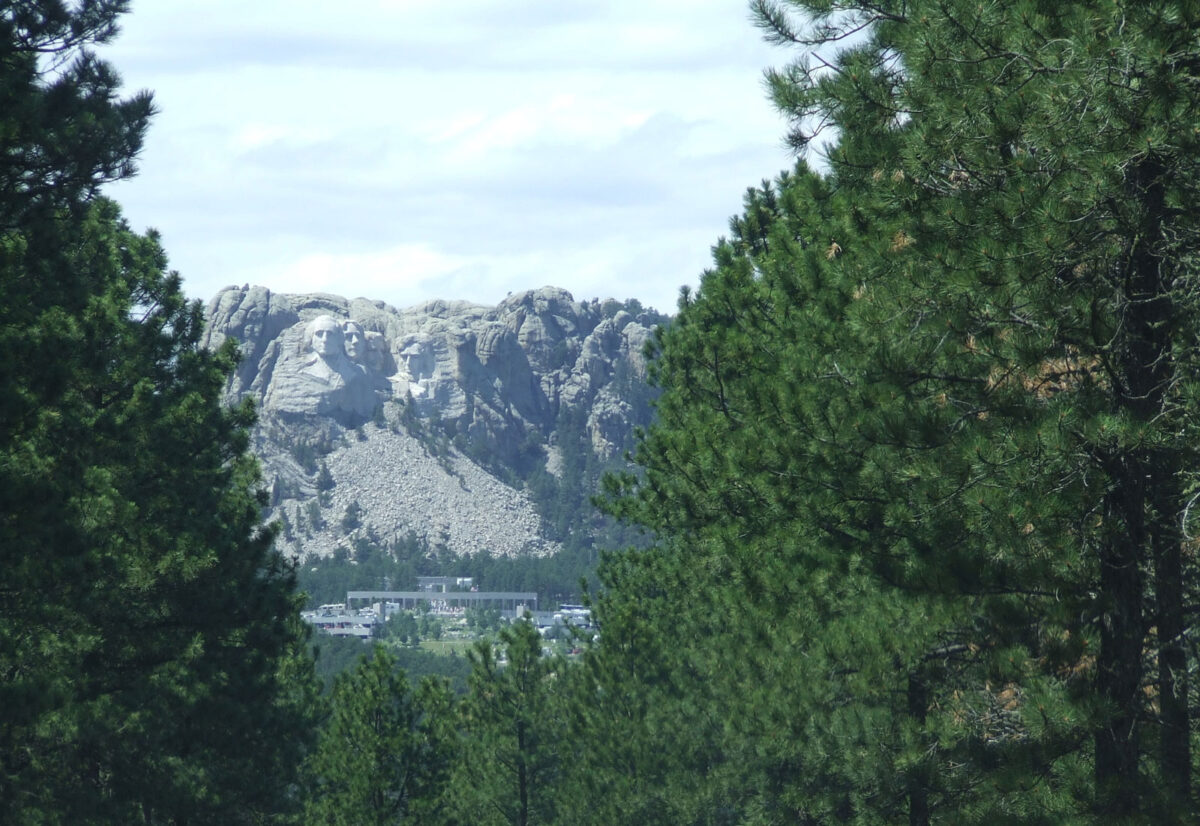The “poster child” for dispossession The Lakota Sioux were given control of land including Mount Rushmore, above, in an 1868 treaty, but lost it after gold was discovered in the South Dakota’s Black Hills. In 1980 the Supreme Court recognized Congress took the land without payment and awarded the Tribe $100 million. Tribal leaders are holding out for return of the land.
The long-term push to restore a portion of ancestral lands to Native American tribes has gained new energy, fueled in part by the efforts of non-profit conservation organizations and private land holders. But some of the most significant return of land has come thanks to the federal government, whose hand was forced by a massive class-action lawsuit.
We explore the issues, personalities, and trends that people are talking about around the West.
In 1996, Elouise Cobell, a banker and a member of the Blackfeet nation, filed suit on behalf of 300,000 Native citizens alleging the Interior and Treasury Departments mismanaged their stewardship of millions of acres of Indian-owned land.
To settle this suit, in 2010 the government committed $1.9 billion to help tribal governments reacquire some three million acres transferred to individual Indian allottees in the late 19th century. This land was largely lost to tribal communities as ownership shares were split multiple times through succeeding generations and mismanaged by the federal government for more than 100 years.
In 2010 the government committed $1.9 billion to help tribal governments reacquire some three million acres transferred to individual Indian allottees in the late 19th century. This land was largely lost to tribal communities as ownership shares were split multiple times through succeeding generations and mismanaged by the federal government for more than 100 years.
The days of Cobell settlement purchases are almost done. The 10-year statutory deadline for disbursing $1.9 billion in buyback funds comes at the end of this month. In any case, the money — set aside to ensure private Native holdings were voluntarily returned to tribal government control — is nearly exhausted.
The purchase of land from Native owners sought to undo a 19th century federal policy, enshrined in the Dawes Act, to phase out communal ownership of reservations. The Cobell settlement belatedly took a significant step in beginning to undo the impact of the 1877 law, providing compensation to heirs of allotment lands willing to sell their “fractional undivided” landholdings. Such lands then reverted to communal tribal ownership.
In 2011, a judge accepted the settlement after the terms were approved by Congress in a law signed by President Obama. Since then, the government has purchased and transferred to tribal governments roughly three million acres, equivalent to 80 percent of the area of Connecticut.
Elouise Cobell and Interior Secretary Ken Salazar during a Senate Indian Affairs Committee hearing in December 2009 The committee was hearing testimony on the proposed settlement in the case of Cobell v. Salazar, a class-action lawsuit filed by Native American representatives against the United States on the grounds that the federal government incorrectly accounted for Indian trust assets belonging to individual Native Americans.
Mark Wilson/Getty Images
What the Cobell settlement did and didn’t do
The return of individually owned Native land to tribal management, together with separate efforts to share land management decisions with tribes, have been two significant developments in the increase of lands under tribal management.
Still, it does not resolve the larger impact of losing hundreds of millions of acres of ancestral lands when reservations were formed, or the subsequent loss of 90 million acres of reservation lands taken under the Dawes Act from Native people who were, at best, forced off the land thanks to deceitful and dishonored treaties, or, at worst, massacred.
“Cobell has a significant size and scale that you never saw before and won’t see again.”
Cris Stainbrook, Indian Land Tenure Foundation
What was the impact of the land purchases after the Cobell settlement? Without it, “at best you would have seen maybe five to ten percent of the land returned” compared to the amounts already returned through the settlement mechanism, said Cris Stainbrook, president of the 20-year-old Indian Land Tenure Foundation.
“Cobell has a significant size and scale that you never saw before and won’t see again,” Stainbrook added. Thanks to the settlement, he said, the federal government “hasn’t solved the problem, but really put a dent in it.”
Stainbrook, an Oglala Lakota, said that Cobell-funded purchases focused on lands of tribes in northern Plains and mountain states because Interior Department officials wanted to make the settlement money go farther, concentrating activity where land was inexpensive.
The western tribal governments receiving the most land from the Cobell settlement include the Blackfeet of Montana (with the equivalent of more than 490,000 acres), the Crow of Montana (more than 418,000 acres) and the Oglala Sioux on the Pine Ridge Reservation in southwestern South Dakota, (more than 350,000 acres). (The equivalent of 400,000 acres is about 750 square miles, or 60 percent of the area of Rhode Island.)
In the Southwest, the Navajo Nation of Arizona, Utah and New Mexico—the largest reservation in the nation with more than 17.5 million acres—had more than 204,000 acres, or the equivalent, returned to tribal ownership through land buybacks.
One group’s early focus on land buybacks pays off
One Northwest tribal group had already been focused on getting their land back before the Cobell settlement: the Confederated Tribes of the Umatilla Reservation – the Umatilla, Cayuse and Walla Walla. When the structures they had created were infused with Cobell funds, their buybacks accelerated.
The Tribes have repurchased more than 77,000 acres in eastern Oregon over the last 33 years. About a quarter of the land, the equivalent of nearly 20,000 acres, was paid for with Cobell settlement funds.

In the early 1980s, Stainbrook said, the tribal managers of the Umatilla reservation “owned around 40 to 45 percent of the reservation…. They wanted to get the entirety of the reservation back in tribal ownership… So they put together a program, and by the time of the Cobell settlement they had developed their own staff expertise to be doing these acquisitions,” Stainbrook said. “Now upwards of 60 to 65 percent of their land is tribally owned.”
The varied groups and the techniques they use to encourage the return of land to Native ownership or stewardship have several names – two of the main ones are “Land Return” and “Land Buy-back.” Stainbrook’s Minnesota-based Indian Land Tenure Foundation has been working with tribes from the northern Plains to the Intermountain West. There is also a South-Dakota-based Native group with a focus on politics and outreach , the NDN Collective. It has adopted an old movement name “Land Back.”
But with whatever name or method, there have been small, medium, and large land transfers to tribes from Oklahoma to Minnesota to the Dakotas and Oregon. In 2016, the Osage Nation of Oklahoma bought a 43,000-acre ranch owned by Ted Turner, the founder of CNN.
Non-profit groups’ success returning land

While the federal government has been a prime source of land returns and has tried to give tribes more of a role in managing federal lands, a Yale e360 report shows non-profit organizations have played a key role in getting lands back into tribal control—although they sometimes put easements on land before turning it over, limiting tribal management options.
The Yale report notes that the Yurok Tribe of northern California has “been piecing back their aboriginal lands” along the Klamath River. The Trust for Public Land and the New Forests investment firm last year partnered with the Yurok Tribe, facilitating the purchase of almost 2,500 acres of forest land.
Through The Conservation Fund, a Virginia-based nonprofit, the Bois Forte Band of Chippewa, an Ojibwe tribe, got control of 28,000 acres on their Minnesota reservation, about 20 percent of the total, two years ago. The land was part of 72,000 acres of land a timber company, PotlachDeltic, had sold to The Conservation Fund.
Conservation Northwest and the Nature Conservancy helped raise the $4.5 million in necessary funds that allowed a 9,243-acre ranch in the Tunk Valley in north-central Washington state to be restored to the Confederated Tribes of the Colville Reservation a year ago. A few months earlier, the Nature Conservancy transferred the 132-acre Safe Harbor Marsh preserve on the Flathead reservation to the Confederated Salish-Kootenai Tribes.
Indian Country Today reported that the nonprofit Ecotrust’s for-profit subsidiary, Ecotrust Forest Management, bought 3,200 acres of coastal land in Oregon and later sold it to the Coquille Tribe. Thereafter, the federal government restored tribal control of other coastal forest land in southwestern Oregon.
Other non-profit organizations have also been the midwives for the return of land to tribal control. In January, a nonprofit group, Save the Redwoods League, , transferred 523 acres of Mendocino County redwood forest to the InterTribal Sinkyone Wilderness Council, which includes 10 federally recognized tribes in Northern California.
Just inland from California’s Big Sur coast, the Esselen tribe two years ago purchased a 1,200-acre ranch for $4.5 million. The purchase was mediated by the Western Rivers Conservancy, a Portland-based environmental group, and supported by a $4.5 million grant from the California Natural Resources Agency.
Other federal support for land return and tribal co-management
While the Interior Department worked to fulfill the terms of the Cobell settlement, Congress also tackled the issue of land return. In September, the House Committee on Natural resources held a hearing on various bills introduced by members from California and Washington that focused on land return. The tribes involved include northern California’s Yurok and Karuk tribes as well as the Confederated Tribes of the Chehalis Reservation and the Lower Elwha Klallam Tribe in Washington.
At the end of 2020, the federal government enacted a law returning land inside the Flathead reservation to the control of the Confederated Salish-Kootenai Tribes. The government had taken control of the 18,766-acre Bison Range, away from the Tribes in 1908.
Earlier this year, Charles F. Sams III, whom the Biden Administration appointed as director of the National Park Service and who is an enrolled member of the Confederated Tribes of the Umatilla Reservation, testified before a congressional committee on efforts to share management, or at least stewardship, of public lands with Native tribes.
He pointed out that Canyon de Chelly National Monument in northeastern Arizona, within the Navajo reservation, is now co-managed by the Navajo. According to Sams’ testimony, in Alaska’s Glacier Bay National Park, members of the Huna Tlingit group, whose traditional activity of harvesting gull eggs was forbidden by the Migratory Bird Treaty, have resumed this springtime practice.
But cautionary voices suggest the impact of co-management arrangements is less than it seems. A lengthy report by Martin Nie and Monte Mills, professors at the University of Montana, recommended changes and argued, “…in exercising [their] discretion, federal public land management agencies regularly disassociate their land management activities from their interactions with tribes, viewing the former as a priority and the latter as an additional burden or only ancillary to their mission.”
Mount Rushmore as the marquee symbol of Native dispossession
Native groups like the South Dakota-based NDN Collective have made Mount Rushmore – the state’s top tourist attraction – the centerpiece of what they see as colonists glorifying the takeover of Indian lands. Their cause was supported by a recent article by an Ojibwe author in The Atlantic magazine.
A National Geographic article explained that, prior to its depression-era creation as a tribute to patriotism, the striking granite formation was a spiritual center that the Lakota and other Plains people, who called it Six Grandfather Mountain. The Sioux were given control of the area in an 1868 treaty. That treaty was broken less than a decade later after gold was discovered in the Black Hills.
More than 60 years of litigation by the Lakota led to a 1980 Supreme Court decision recognizing that Congress broke the treaty and illegally took the land without compensation. It gave a monetary award of $100 million.
As Smithsonian magazine recounts, the Sioux nation refused the money; it wanted the land back.
Small-scale land returns can have outsized significance
The Amah Mutsun Tribal Band, another group on California’s central coast which lacks federal recognition, has created the Amah Mutsun Land Trust. Through this organization, tribal members help manage tracts of land belonging to federal land-management agencies, to California’s parks and to private nonprofits like the Midpeninsula Regional Open Space District.
Another recent case where perhaps symbolism mattered as much as scale, a private landowner in the Altadena neighborhood of northern Los Angeles transferred a one-acre family property she had inherited to the Gabrieleno/Tongva Tribe, giving them back an historic gathering place.
As Kimberly Morales Johnson, vice president of the Tongva Taraxat Paxaavxa Conservancy, told The Los Angeles Times, “We’re working towards one common goal, and that is to have a place of safety, security, where we can have ceremonies and where we can exercise our self-determination.”
What does land return mean? For some, it’s a crucial element in embracing traditional culture. In an interview with Crosscut, Charlotte Coté of the Canadian Tseshaht/Nuu-chah-nulth First Nation, said, “reclamation means being able to subsist on those lands, practice ceremonies that are sacred to those specific lands, revitalizing those relationships to those lands.”
Edited by Geoff McGhee.


























